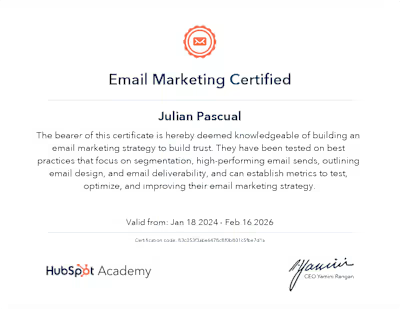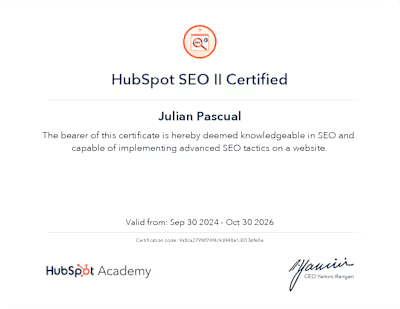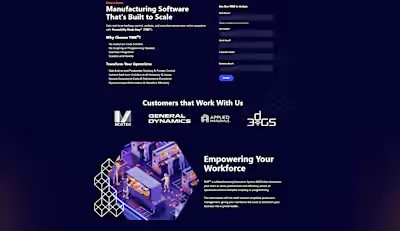User Persona Analysis for B2B Software Company
Overview:
Name: Amanda Lee
Age: 38
Gender: Female
Education Level: Bachelor's degree in Quality
Management
Location: Chicago, IL
Tech Literacy Level: Intermediate - Comfortable
learning new software related to job duties
Personality: Detail-oriented, analytical,
collaborative, patient
Extrovert/Introvert: Ambivert - Comfortable in groups
or working independently
Current System: Excel, paper-based processes, basic
quality management software
Industry Segment: Medical device manufacturing
Company Size: $26m – $50m, 100 employees
Number of Employees: Oversees a team of 12 quality
and compliance associates
Number of Users: Would be one of the primary users
and administrators of the MES software. About 15 total users across quality
team.
Skills:
Problem-Solving: The ability to identify and address
quality issues systematically by employing problem-solving methodologies like
root cause analysis (e.g., 5 Whys, Fishbone diagrams).
Analytical Skills: Strong data analysis skills to
interpret quality metrics, trends, and patterns and make data-driven decisions.
Communication: Effective communication skills to
convey quality expectations, report issues, and collaborate with
cross-functional teams.
Leadership: Leadership and management skills to lead
quality improvement initiatives, motivate teams, and drive a culture of quality
excellence.
Attention to Detail: A keen eye for detail to spot
defects or deviations in products or processes.
Project Management: Skills to plan and execute
quality improvement projects, set objectives, allocate resources, and monitor
progress.
Regulatory Knowledge: Familiarity with
industry-specific regulations and quality standards, such as ISO standards, FDA
regulations, or other relevant standards for the sector.
Quality Tools: Proficiency in using quality
management tools like Statistical Process Control (SPC), Failure Mode and
Effects Analysis (FMEA), and Control Plans.
Training and Development: The ability to design and
deliver training programs to enhance the quality-related skills of team
members.
Auditing Skills: Knowledge and experience in
conducting internal and external quality audits.
Knowledge:
Quality Management Systems: Understanding of quality
management systems (QMS) and how to establish and maintain them effectively.
Industry-Specific Knowledge: Knowledge of
industry-specific quality requirements and best practices, particularly in the
context of the manufacturing sector.
Statistical Analysis: Understanding of statistical
methods and tools for process analysis and improvement.
Continuous Improvement Methodologies: Familiarity
with methodologies like Six Sigma, Lean, Total Quality Management (TQM), and
their application to achieve quality goals.
Regulatory Compliance: Knowledge of relevant
regulatory requirements and the ability to ensure compliance.
Materials and Processes: Understanding of
manufacturing materials and processes to identify potential quality issues.
Quality Documentation: Knowledge of documentation
requirements for maintaining quality records and demonstrating compliance.
Tools:
Quality Management Software: Utilizing quality
management software systems to streamline documentation, data analysis, and
reporting.
Statistical Software: Software tools like Minitab or
statistical packages within spreadsheet software for data analysis and process
control.
Project Management Tools: Tools like Microsoft
Project or project management software for planning and tracking quality
improvement projects.
Quality Metrics and Reporting Tools: Software for
collecting and analyzing quality-related data and generating reports.
Collaboration and Communication Tools: Platforms for
team collaboration, communication, and document sharing.
Audit Management Software: Software for managing and
conducting quality audits.
Training and eLearning Platforms: Systems for
developing and delivering training programs.
Core Needs:
Data Management
Requires a robust platform to aggregate quality data, ensure integrity and
accessibility of historical records, and enable detailed analysis.
Compliance Control
Seeks capabilities to automate compliance processes, access real-time
quality metrics, and generate detailed documentation for audits and
regulations.
Corrective Action Tools
Wants features like root cause analysis, problem solving workflows, and
corrective/preventative action management to proactively address issues.
Traceability
Requires lot, batch and serial traceability for materials and finished
goods to ensure quality standards and meet compliance.
Flexible Reporting
Desires customizable reporting templates and analytics dashboards to
extract key insights and track different metrics.
Frustrations:
Maintaining Compliance: Staying up-to-date with
evolving industry regulations and standards, such as ISO standards or FDA
requirements, and ensuring that your organization remains compliant.
Consistent Quality: Ensuring that products
consistently meet or exceed quality standards and customer expectations, even
as production scales up or processes change.
Problem Solving: Effectively addressing and resolving
quality issues, conducting thorough root cause analyses, and implementing
corrective and preventive actions to prevent recurrence.
Data Management: Managing and analyzing large volumes
of data to identify trends, patterns, and areas for improvement. This includes
selecting and using appropriate quality metrics.
Resource Constraints: Balancing the need for quality
improvements with budget and resource limitations, especially in smaller
organizations.
Process Changes: Managing the introduction of new
processes or technologies while minimizing disruptions to ongoing production
and ensuring that quality standards are maintained.
Cross-Functional Collaboration: Collaborating with
teams from various departments, including production, engineering, and supply
chain, to align quality goals with broader business objectives.
Supplier Quality: Ensuring that materials and
components supplied by external vendors meet the required quality standards and
integrating supplier quality management into your processes.
Cultural Change: Fostering a culture of quality and
continuous improvement throughout the organization, which may require changing
mindsets and behaviors.
Audits and Inspections: Preparing for and
successfully navigating internal and external audits and inspections to
demonstrate compliance and address any findings.
Training and Development: Developing and maintaining
a skilled workforce with up-to-date quality-related knowledge and skills.
Technology Adoption: Assessing and implementing new
quality management technologies and software solutions to streamline processes
and improve efficiency.
Balancing Short-Term vs. Long-Term Goals: Striking a
balance between addressing immediate quality issues and pursuing long-term
quality and process improvement goals.
Change Management: Effectively managing and
communicating changes in quality processes, procedures, or systems to ensure
buy-in and successful adoption by team members.
Market Demands: Adapting to changing customer demands
and market conditions while maintaining product quality.
Pain Points:
Inefficient Compliance Processes
Manual documentation and tracking of quality metrics substantially
increases the effort required for regulatory compliance.
Data Consistency Issues
Reliance on error-prone spreadsheets results in data discrepancies and
inconsistencies, hindering reporting accuracy.
Long Corrective Action Cycles
Lengthy investigations and root cause analysis of issues due to scattered
data and lack of centralized workflow.
Limited Quality Analytics
Difficulty accessing and analyzing real-time trends in quality to identify
risks and opportunities for improvement.
Traceability Gaps
Inability to efficiently trace components, batches and end products limits
quality issue analysis and containment capability.
Motivation:
Compliance Adherence
Wants to improve compliance program effectiveness to reduce risks of fines
and shutdowns.
Quality Improvement
Seeks to drive higher, more consistent product quality, lower customer
defects and stronger brand reputation.
Error Reduction
Motivated to minimize human errors caused by manual processes and gain
data-driven insights.
Process Efficiency
Wants to reduce repetitive, cumbersome documentation and reporting for more
strategic work.
Lead Proactive Initiatives
Desires to gain insights to get ahead of issues and implement preventative
quality actions.
Objections:
New System Investment
Concerns about costs, time and effort required to implement, validate and
learn a new MES system.
Customization Limitations
Worried the system won't be configurable enough to meet specialized quality
workflows and processes.
Data Migration
Apprehension about accurately transferring historical data into new system
without losses.
Employee Buy-in
Hesitant about getting team on board, adopting new behaviors required by
the system.
Proof Challenges
Wants reassurance new MES can actually deliver the promised ROI and
results.
What are they responsible for?
To provide information and respond to inquiries and tasks
related to quality management in a manufacturing context.
Quality Assurance: Ensuring that products or
processes meet established quality standards and compliance requirements.
Quality Control: Monitoring and inspecting production
processes and products to identify and address defects or deviations from
quality standards.
Process Improvement: Identifying opportunities for
process optimization and implementing improvements to enhance quality and
efficiency.
Risk Assessment: Evaluating potential risks to
product quality and developing strategies to mitigate them.
Root Cause Analysis: Investigating the causes of
quality issues and implementing corrective and preventive actions.
Documentation: Maintaining quality records,
documentation, and reports to demonstrate compliance with quality standards.
Training: Providing training and guidance to team
members to ensure they understand and adhere to quality procedures.
Supplier Quality Management: Evaluating and managing
the quality of materials and components supplied by external vendors.
Audits and Inspections: Conducting internal audits
and participating in external audits to assess compliance with quality
standards.
Continuous Improvement: Promoting a culture of
continuous improvement and quality excellence within the organization.
What does it mean to be successful in this role?
Quality Standards Compliance: Ensuring that products
or processes meet established quality standards, regulatory requirements, and
industry best practices. This includes maintaining compliance with standards
such as ISO 9001, ISO 13485 (for medical devices), or other relevant quality
standards.
Defect Reduction: Effectively managing and reducing
defects or non-conformities in products or processes. This involves
implementing robust quality control measures and conducting root cause analyses
to address issues at their source.
Process Optimization: Identifying and implementing
process improvements to enhance efficiency, reduce waste, and maintain
consistent product quality. Continuous process improvement methodologies, such
as Six Sigma or Lean, are often utilized.
Risk Mitigation: Identifying and proactively
addressing potential risks to product quality or safety. This may involve risk
assessments, failure mode and effects analysis (FMEA), and risk mitigation
strategies.
Customer Satisfaction: Ensuring that products meet or
exceed customer expectations in terms of quality and reliability. Monitoring
customer feedback and addressing issues promptly are essential.
Data-Driven Decision-Making: Using data and metrics
to drive decision-making and monitor quality performance. Analyzing trends and
making informed adjustments to processes based on data insights.
Cross-Functional Collaboration: Collaborating
effectively with various departments, including production, engineering, supply
chain, and senior management, to align quality goals with broader business
objectives.
Regulatory Compliance: Ensuring compliance with
relevant industry regulations and standards, including FDA regulations for
industries like pharmaceuticals and medical devices.
Training and Development: Providing training and
development opportunities for team members to enhance their quality-related
skills and knowledge.
Audit Readiness: Maintaining documentation and
processes that are audit-ready for both internal and external audits,
demonstrating a commitment to quality and compliance.
Cost Efficiency: Achieving quality goals while
managing costs effectively. This includes minimizing scrap, rework, and waste.
Continuous Improvement Culture: Fostering a culture
of continuous improvement and quality excellence throughout the organization.
How do they learn new information?
Continuous Education: Engaging in ongoing education
and professional development, such as attending workshops, seminars, webinars,
and industry conferences related to quality management and relevant
regulations.
Certifications: Pursuing relevant certifications,
such as Six Sigma, Lean, or Certified Quality Manager (CQM), to acquire new
skills and knowledge in quality management.
Industry Associations: Becoming a member of
industry-specific associations or organizations that provide access to
resources, networking opportunities, and the latest industry updates.
Networking: Actively participating in professional
networks, both online and offline, to exchange knowledge and experiences with
peers in the field.
Reading Industry Journals: Subscribing to and reading
industry-specific journals, magazines, and publications that cover the latest
trends, case studies, and best practices in quality management.
Online Resources: Leveraging online resources such as
industry forums, blogs, and websites to access articles, discussions, and
expert insights on quality management topics.
Training Programs: Enrolling in formal training
programs offered by educational institutions or industry training providers to
acquire specific skills or knowledge related to quality management.
Vendor and Supplier Training: Collaborating with
vendors and suppliers who provide training on new materials, components, or
technologies relevant to quality improvement.
Internal Knowledge Sharing: Encouraging knowledge
sharing and cross-functional collaboration within the organization to learn
from colleagues and subject matter experts in different departments.
Benchmarking: Engaging in benchmarking activities to
compare the organization's quality practices with those of industry leaders and
identify areas for improvement.
Consulting Experts: Seeking guidance from industry
experts and consultants who specialize in quality management and can provide
insights and recommendations.
Quality Management Software: Utilizing quality
management software and tools that offer real-time data and analytics to
identify trends and areas for improvement within the organization.
Audits and Assessments: Conducting regular internal
audits and assessments to identify weaknesses and areas for improvement in
quality processes.
Feedback and Customer Input: Listening to customer
feedback and input to understand their changing needs and expectations and
adapting quality management practices accordingly.
Regulatory Updates: Staying informed about updates
and changes in relevant regulations and standards, such as ISO standards or FDA
guidelines.
What do they read?
Regulations and Standards: Staying up-to-date with
industry-specific regulations and quality standards relevant to your
organization's products or services is essential. This might include reading
documents from regulatory agencies like the FDA, ISO standards, or
industry-specific guidelines.
Quality Manuals and Procedures: Reviewing and
updating quality manuals, procedures, and work instructions to ensure that they
align with the latest standards and best practices.
Quality Reports: Analyzing quality reports, which may
include data on product defects, non-conformances, customer complaints, and
quality performance metrics.
Audit Reports: Studying internal and external audit
reports to identify areas for improvement and ensure compliance with quality
standards.
Technical Documents: Reading technical
specifications, product drawings, and engineering documents to understand
product requirements and quality control parameters.
Training Materials: Reviewing training materials to
ensure that employees are adequately trained in quality processes and
procedures.
Industry Publications: Reading industry-specific
journals, magazines, and publications to stay informed about the latest trends,
case studies, and best practices in quality management.
Quality Improvement Plans: Reviewing and updating
quality improvement plans based on data analysis and continuous improvement
initiatives.
Root Cause Analysis: Engaging in root cause analysis
reports to identify the underlying causes of quality issues and develop
effective corrective and preventive actions.
Customer Feedback: Reviewing customer feedback,
including complaints and surveys, to understand customer expectations and areas
where quality improvements are needed.
Supplier Documentation: Examining documentation from
suppliers to ensure the quality of incoming materials and components.
Quality Management Software Reports: Utilizing
quality management software tools to generate and review reports on quality
metrics, process performance, and compliance.
Benchmarking Reports: Studying benchmarking reports
to compare your organization's quality performance with industry peers and
identify opportunities for improvement.
Industry Research: Keeping up with industry research
and reports that provide insights into emerging technologies, market trends,
and competitive analysis.
Management Updates: Reading updates and reports from
upper management regarding the organization's quality performance and strategic
goals.
How do they search for information?
Online Research: Conducting online research using
search engines like Google to find relevant articles, reports, and resources
related to quality management, industry standards, and regulatory updates.
Industry-Specific Websites: Visiting
industry-specific websites, forums, and portals that provide insights, news,
and resources tailored to the particular sector in which your organization
operates.
Professional Networks: Leveraging professional
networks and associations related to quality management, such as ASQ (American
Society for Quality) or industry-specific groups, to access resources and
connect with peers.
Subscription Services: Subscribing to industry
journals, magazines, newsletters, and publications that regularly provide
updates on quality trends, best practices, and case studies.
Government and Regulatory Websites: Monitoring
government and regulatory agency websites (e.g., FDA, ISO) for the latest
guidelines, standards, and compliance requirements relevant to your industry.
Library Resources: Utilizing your organization's or
local library's resources, including access to databases, research journals,
and academic publications.
Online Courses and Training: Enrolling in online
courses, webinars, and training programs offered by reputable institutions and
organizations to acquire new knowledge and skills in quality management.
Supplier and Vendor Documentation: Reviewing
documentation provided by suppliers and vendors to ensure that materials and
components meet quality standards.
Internal Documents: Accessing internal documents,
such as quality manuals, standard operating procedures (SOPs), and audit
reports, to gather information about current quality practices and performance.
Quality Management Software: Using quality management
software and tools to generate reports, track metrics, and analyze data related
to quality processes and compliance.
Benchmarking: Engaging in benchmarking activities to
compare your organization's quality performance with industry leaders and
gather insights for improvement.
Conferences and Seminars: Attending industry
conferences, seminars, and workshops to learn from subject matter experts,
share experiences, and gain exposure to the latest quality management
practices.
Consultation with Experts: Seeking guidance and
advice from external experts and consultants who specialize in quality
management and can provide valuable insights and recommendations.
Customer Feedback: Analyzing customer feedback,
complaints, and surveys to understand customer expectations and identify areas
where quality improvements are needed.
Knowledge Sharing within the Organization:
Encouraging knowledge sharing and collaboration among team members and
departments to tap into internal expertise and best practices.
What are the consequences of inaction?
Increased Costs: Failing to adopt more efficient
quality management solutions can lead to ongoing and potentially rising
operational expenses.
Lost Opportunities: Inaction may result in missed
opportunities to enhance revenue, such as acquiring new clients, upselling, or
improving customer retention.
Reduced Efficiency: Maintaining outdated processes or
systems can hinder productivity, necessitating more time and effort to achieve
desired outcomes.
Inefficient Resource Allocation: Without embracing
new solutions, staff may continue manual tasks that could be automated, leading
to inefficient resource allocation.
Falling Behind: Competitors who swiftly embrace new
strategies, technologies, or processes gain a competitive advantage.
Outdated Offerings: Neglecting updates to products or
services in line with market trends can make offerings appear outdated or less
attractive.
Quality Decline: Without improvements or upgrades,
product or service quality may deteriorate over time.
Compliance Vulnerability: Neglecting system or
process updates can result in non-compliance with evolving regulations,
carrying financial and reputational risks.
Customer Perception: Inaction can lead to a
perception of stagnation, potentially tarnishing the brand's image.
Employee Morale: Failing to invest in new tools or
processes can affect employee satisfaction and retention negatively.
Missed Collaborations: Refraining from action may
lead to missed opportunities for strategic partnerships that could benefit the
business in the long term.
Innovation Limitations: A resistance to change can
leave the company stagnant, hindering innovation and adaptation to evolving
market demands.
How do they prefer to interact with vendors?
Regular Communication: Establishing regular
communication channels with vendors to discuss quality expectations,
requirements, and updates. This can include scheduled meetings, email
correspondence, and phone calls.
Vendor Audits: Conducting vendor audits to assess
their quality management systems, production processes, and adherence to
quality standards. These audits can be scheduled periodically or in response to
specific concerns.
Quality Agreements: Developing and maintaining
quality agreements or contracts with vendors that outline quality
specifications, performance expectations, and compliance requirements.
Collaborative Problem-Solving: Collaborating with
vendors to address quality issues, defects, or non-conformances promptly. This
may involve root cause analysis and corrective action planning.
Performance Metrics: Establishing key performance
indicators (KPIs) and quality metrics to track vendor performance over time.
Regularly reviewing these metrics with vendors to identify areas for
improvement.
Supplier Development Programs: Implementing supplier
development programs to help vendors improve their quality management processes
and capabilities. This can include training and support.
Quality Documentation: Requiring vendors to provide
necessary quality documentation, such as certificates of analysis, inspection
reports, and compliance certificates, to verify the quality of supplied
materials.
Product Inspections: Conducting inspections of
incoming materials and components to ensure they meet quality specifications
before they are used in production.
Continuous Improvement: Encouraging vendors to
participate in continuous improvement initiatives, such as Lean Six Sigma, to
enhance their processes and reduce defects.
Feedback Mechanisms: Establishing feedback mechanisms
where both parties can openly discuss issues, share suggestions, and work
together to resolve challenges.
Collaborative Problem-Solving: When quality issues
arise, Quality Managers often prefer a collaborative approach with vendors to
identify root causes and implement corrective actions effectively.
Vendor Qualification: Developing a vendor
qualification process to evaluate and approve new vendors based on their
quality capabilities and performance history.
Regulatory Compliance: Ensuring that vendors comply
with industry-specific regulations and standards, especially if your
organization operates in a highly regulated sector like healthcare or
aerospace.
Conflict Resolution: Having a clear process for
conflict resolution in case disagreements or disputes arise between your
organization and a vendor.
Openness to Feedback: Being receptive to feedback from vendors regarding your organization's quality requirements and processes,
as this can lead to mutually beneficial improvements.
What did their most recent purchase look like?
Purchase: Upgrading Quality Testing Equipment
Description: The organization identified a need to enhance the accuracy and efficiency of quality testing procedures for a critical production line. After a thorough assessment of available options and consultation with the quality team, a decision was made to invest in advanced testing equipment.
Reason for Purchase:
Improve product quality and reliability.
Reduce the time required for quality inspections.
Enhance data collection capabilities for process optimization.
Ensure compliance with industry-specific quality standards.
Purchase Process:
Needs Assessment: The Quality Manager, in collaboration with the quality team, conducted an assessment to determine the specific requirements for the new testing equipment.
Vendor Selection: After researching and evaluating potential vendors, a reputable supplier known for high-quality testing equipment was chosen.
Budget Approval: The Quality Manager worked with the finance department to secure the necessary budget for the purchase, providing a cost-benefit analysis to justify the investment.
Procurement: The purchase was initiated, and the equipment was ordered from the selected vendor. This process included negotiating terms, such as delivery schedule and warranty.
Installation and Training: Upon delivery, the new testing equipment was installed by the vendor's technicians, and training sessions were conducted for the quality team to ensure proper use.
Quality Assurance: The Quality Manager oversaw the initial testing using the new equipment to confirm its accuracy and reliability. Any issues were addressed promptly.
Integration: The equipment was integrated into the production process, streamlining quality control procedures.
Documentation: Detailed records of the purchase, installation, and training were maintained to ensure compliance and for future reference.
Key Pros When Comparing Solutions:
Feature Set: Compare the comprehensiveness of features, covering production monitoring, quality control, and traceability.
Ease of Use: User-friendliness and training requirements for quick adoption.
Integration: How well the software integrates with existing systems to reduce data silos.
Scalability: Ensure the solution can scale with business growth.
Compliance: Verify compliance support for industry standards and regulations.
Key Cons When Comparing Solutions:
Cost: Initial, ongoing, and customization.
Customization: Evaluate the complexity of required customizations.
Implementation Time: Consider the time needed to go live with the solution.
User Training: Assess training needs and their impact on productivity.
Vendor Reputation: Research vendor reliability and support history.
Data Security: Examine data security measures.
Support and Maintenance: Evaluate the quality of vendor support.
Scalability: Ensure the software can handle growth and has the ability to scale.
User Adoption: Consider workforce adjustment to new workflows.
Like this project
Posted Apr 23, 2024
This is one example of a comprehensive user persona analysis. The idea is to fully analyze your personas so you can understand the best way to market to them.
Likes
0
Views
8





